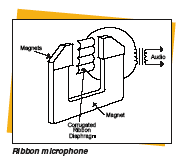5--Electret And Ribbon Microphones
In recent years, there has been an avalanche of cheap condenser microphones from China flooding the market under many different brand names. Their frequency responses seem to look wide on paper, lots of lows and highs, but they lack midrange and are harsh and rumbly. They have variable or switchable patterns, but careful listening proves these patterns are at higher frequencies and mid to lower frequencies are often nearly omnidirectional! This causes the mic to be increasingly sensitive to the room acoustics and will not reject off axis (not in front) sounds. Beware of these cheap condensers! They look pretty, have a nice price, are common in stores but leave a lot to be desired in real applications. For many, owning a "condenser" microphone has become a great ego boost and has little to do with it's actual performance.Electret Microphones
An Electret microphone is a small version of a large diameter condenser. Using an internal Field Effect Transistor, the Electret can usually be powered from an internal battery or phantom (console supplied) power. Their primary advantage has been size and you will find them on the lapels of TV anchors and news folk. They do not exhibit the extreme sensitivity of the large diaphragm studio condenser but they are still vulnerable when placed in and around high SPL situations. Care in handling the delicate Electret has to be taken since they do have sub miniature internal electronic components. They are best at voice, but expensive versions can offer wider response and wider applications.
Ribbon Microphones
 The ribbon microphone was popular in the early days of audio back in the
1930s, '40s and '50s. Using a metal bifurcated ribbon stretched between two
poles of a large heavy permanent magnet, these microphones were
noted for their wonderful midrange, warm tone and great bass response. Unfortunately they are very fragile and cannot take loud sounds (high SPL). The ribbon is easily broken if dropped or mishandled. Even blowing into them ("Hey, "whoooof" is this on?") would often fracture early ribbons. The other issue with ribbons was very low output.
Special high gain mic preamps were employed to get sufficient gain from the microphones.
The ribbon microphone was popular in the early days of audio back in the
1930s, '40s and '50s. Using a metal bifurcated ribbon stretched between two
poles of a large heavy permanent magnet, these microphones were
noted for their wonderful midrange, warm tone and great bass response. Unfortunately they are very fragile and cannot take loud sounds (high SPL). The ribbon is easily broken if dropped or mishandled. Even blowing into them ("Hey, "whoooof" is this on?") would often fracture early ribbons. The other issue with ribbons was very low output.
Special high gain mic preamps were employed to get sufficient gain from the microphones.
Ribbon technology was stagnant for many years but a few companies have brought some new technology back into this arena lately. The durability has increased and output has improved but these mics still remain best at recording applications.